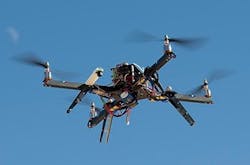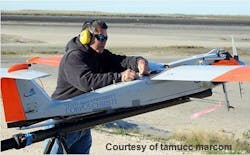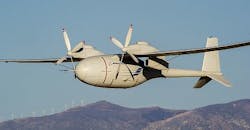Unmanned aircraft system market to triple by 2020, driven by commercial and DIY applications
COQUITLAM, B.C., Canada, 16 Oct. 2014. The unmanned aircraft systems (UAS) market in the United States will grow from $5 billion in 2013 to $15 billion in 2020, according to IGI Consulting Inc. in Coquitlam, British Columbia.
The UAS market will be driven by growth in the commercial and do-it-yourself (DIY) markets, IGI Consulting officials predict. Major commercial applications include: agriculture, real estate, filmmaking, oil and gas pipeline, electric utility, and specialized package delivery.
There will be a significant growth in 2015 after the U.S. Federal Aviation Administration (FAA) decision on UAS access to the National Airspace System (NAS).
"This is the first market Research Study to assess the size and growth of the total UAV market from large DOD UAVs to Do-it-Yourself (DIY) UAVs for amateurs," says a spokesperson.
The study includes the following major market sectors including:
- DOD
- Civil
- Commercial
- SUAS
- DIY Amateur
- Radio Control
Table of Contents
1.0 Introduction
2.0 Historical Developments
2.1 UAV Growth in the Military
2.2 UAV Flight Hours
2.3 Remotely Controlled Aircraft and the Hobby Industry
3.0 UAV Market Segments
3.1 Introduction
3.2 Department of Defense (DoD)
3.2.1 Requirements in Development and Systems Acquisition
3.2.2 Unmanned Systems Applied to Joint Capability Areas
3.2.3 Battlespace Awareness (BA)
3.2.4 Force Application (FA)
3.2.5 Protection
3.2.6 Logistics
3.2.7 Unmanned Aircraft Systems (UAS)
3.2.8 Unmanned Ground Systems (UGS)
3.2.9 Unmanned Maritime Systems (UMS)
3.2.10 Challenges for Unmanned Systems
3.2.11 Interoperability
3.2.12 Autonomy
3.2.13 Airspace Integration (AI)
3.2.14 Communications
3.2.15 Training
3.2.16 Propulsion and Power
3.2.17 Manned-Unmanned (MUM) Teaming
3.3 Civil Applications
3.3.1 Federal Organizations
3.3.2 Regulators
3.3.3 FAA
3.3.2.1 Autonomy Research for Civil Aviation
3.3.4 NASA
3.3.4.1 Autonomy Research for Civil Aviation [NASA Headquarters]
3.3.4.2 UAS-NAS Project OV-1 [NASA Armstrong]
3.3.4.3 Low Altitude Airspace Control System [NASA Ames]
3.3.4.4 Hybrid Electric Propulsion for UAS [NASA Langley]
3.3.4.5 Civil UAV Capabilities Assessment
3.3.4.6 Integrated Systems Research Program
3.3.4.7 Unmanned Aerial Systems Airspace Operations Challenge
3.3.4.8 Environmentally Responsible Aviation Project
3.3.4.9 Sense, Detect, and Avoid (SDA)
3.3.5 National Oceanic & Atmospheric Administration (NOAA)
3.3.6 Department of Homeland Security (DHS)
3.3.7 Department of Energy (DOE)
3.3.8 National Interagency Aviation Council (NIAC)
3.3.9 Department of the Interior (DoI)
3.3.9.1 Objectives for Sensing
3.3.10 Federal Communications Commission (FCC)
3.3.11 National Telecommunications and Information Administration (NTIA)
3.4 Commercial Applications
3.4.1 Commercial Cost Advantages of UAVs
3.4.2 FAA Schedule – Small UAS Notice of Proposed Rulemaking
3.4.3 First Approved Commercial FAA Certification
3.4.4 Commercial UAS Use in Other Countries
3.5 Small Unmanned Aircraft Systems (SUAS)
3.6 DIY Drones for Amateurs
3.7 Radio Controlled DIY Drones
4.0 FAA
4.1 Introduction
4.1.1 National Airspace Classification
4.2 FAA Accomplishments
4.3 Test Facilities
4.4 UAS Centers of Excellence
4.5 Regulations and COAs
4.6 Small UAS Notice for Proposed Rulemaking
4.7 FAA Exemptions
4.8 The FAA and Model Aircraft Hobbyists
4.8.1 The FAA’s Interpretation of “Special Rule for Model Aircraft”
4.9 FAA UAS Roadmap
4.10 FAA FAQ and Model Aircraft Ruling
4.10.1 Political and Industry Pressure on the FAA from AUVSI and 30 Other Groups
5.0 Market Forecasts
5.1 Market Overview
5.2 Defense Market
5.3 Civilian Market
5.4 Commercial Market
5.5 Small UAS Market
5.5.1 First Approved Commercial FAA Certification
5.5.2 Estimated Growth of SUAS in the U.S
5.5.3 Estimated Growth of SUAS in Other Countries
5.5.4Canadian Definition of UAV
5.6 DIY – Amateur Market
5.7 Radio Controlled Model Aircraft Market
5.8 Barriers to Growth
5.8.1 Export Control Rules on UAS
6.0 UAV Standards
6.1 FAA Roadmap
6.2 RTCA, Inc. 6.2.1 Sunsetted Special Committee 203 (SC-203) – Unmanned Aircraft Systems
6.2.2 Sunsetted Special Committee 228 (SC-228) – Minimum Operational Performance Standards for UAS
6.2.3 NextGen Advisory Committee (NAC)
6.3 SAE International
6.4 ASTM International
7.0 Technology Trends
7.1 Sense, Detect, and Avoid
7.2 SUAS
7.2.1 Strong Demand for Small UAS with Unique Capabilities
7.3 NextGen Drones
7.3.1 Done Discord: Navy plan for carrier-based robotic aircraft sparks debate
7.4 Fiber Optic Sensors for UAVs
7.5 Major Issues in UAV Backbone Wiring
8.0 Associations
8.1 Association for Unmanned Vehicle Systems International (AUVSI)
8.2 Academy of Model Aeronautics (AMA)
8.3 Hobby Manufacturers Association (HMA)
8.4 Remote Controlled Aerial Photography Association (RCAPA)
8.5 Motion Picture Association of America (MPAA)
8.6 National Retail Hobby Stores Association (NRHSA)
8.7 Do-It-Yourself (DIY)
9.0 Test Facilities
10.0 Export Controls
11.0 Roadmaps
12.0 Publications
13.0 Systems Suppliers
14.0 Appendix
14.1 Glossary
14.2 FAA Roadmap
14.3 Test Facilities (Other Than FAA)
14.4 FAA Interpretations of Model Aircraft
14.5 Agency Contacts






